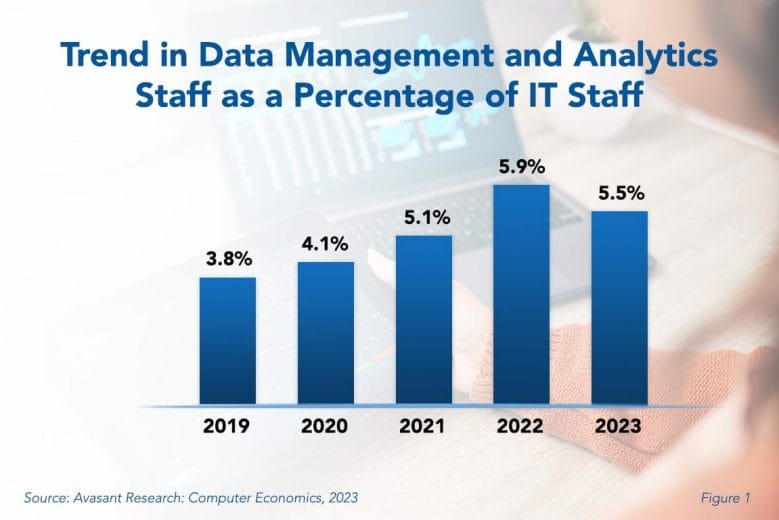The amount of data that IT organizations need to manage is growing with no end in sight. Whether it be sensor data from IoT devices, social networking data, online advertising and e-commerce transactions, or multimedia files, the complexity of the data to be analyzed is also increasing. With the continued growth of data and its importance in the day-to-day activities of organizations, it is surprising that the data management and analytics function has decreased this year.
This function now represents 5.5% of the IT staff, down from 5.9% last year, as shown in Figure 1 from our full report, Data Management and Analytics Staffing Ratios . Through the 2010s, organizations were able to maintain data management and analytics head count at about 3.8%. So, despite the recent decline, the current 5.5% still represents a high level of staffing. But has data management staffing now peaked?

To answer that, it helps to look at what held back growth in staffing for several years. It is likely that the tools in the hands of data management and analytics professionals were making them more productive. These include cloud-based business analysis and reporting tools. Moreover, analytical tools embedded within application systems, such as enterprise resource planning, customer relationship management, and human capital management, and more powerful, self-service reporting tools directly in the hands of users were reducing the reliance on data management and analytics staff for routine reporting.
“During the pandemic, organizations increased staffing quickly at an unsustainable rate,” said Reneece Sterling, a research analyst for Avasant Research, based in Los Angles. “Even with the exponential growth in data, organizations have now realized that demand is not as great as they anticipated. Staffing is simply returning to normal levels.”
We define the data management staff as those individuals who design, develop, architect, and model data schemas and databases for the organization. They also may design the organization’s data warehouse and business intelligence systems and analyze information maintained by such systems. This category does not include database administrators, who reside in the database administration category. A complete listing of our IT staffing categories is in the Appendix of the PDF version of the full report.
To examine this important IT staffing question, the full report uses four benchmarks to assess data management staffing levels: data management staff as a percentage of the IT staff, data management staff as a percentage of the Application Group, users per data management staff member, and applications per data management staff member.
This Research Byte is a brief overview of our report on this subject, Data Management Staffing Ratios. The full report is available at no charge for subscribers, or it may be purchased by non-clients directly from our website (click for pricing).

